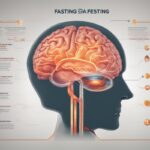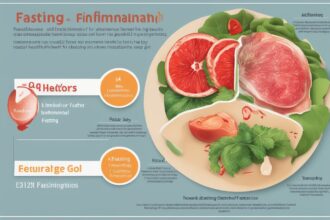Hey there, health enthusiasts! If you’re on a journey to optimize your wellness, you’ve likely stumbled across the buzz surrounding fasting and its potential benefits. One area where fasting truly shines is in inflammation reduction—a key factor in preventing chronic diseases and improving overall health. In this comprehensive fasting guide, we’ll dive deep into how fasting can help tame inflammation, explore the science behind it, and provide actionable tips to integrate fasting into your lifestyle. Whether you’re new to fasting or a seasoned pro, this post will equip you with the knowledge and tools to harness its anti-inflammatory power. Let’s get started on this transformative path together!
What Is Inflammation and Why Does It Matter?
Inflammation is your body’s natural response to injury or infection, a crucial part of the healing process. Think of it as your immune system’s way of saying, “Hey, we’ve got a problem here!” However, when inflammation becomes chronic—lingering for months or even years—it can wreak havoc on your health. Chronic inflammation is linked to conditions like heart disease, diabetes, and autoimmune disorders (Rohleder, 2019). So, reducing unnecessary inflammation is vital for long-term wellness. This is where fasting comes in as a powerful tool. By following a well-structured fasting guide, you can potentially lower inflammation markers and give your body a much-needed reset. But how does it work? Let’s break it down.
How Fasting Impacts Inflammation: The Science Explained
Fasting, the practice of abstaining from food for a specific period, triggers several physiological changes that can combat inflammation. One key mechanism is autophagy—a cellular “clean-up” process where your body recycles damaged cells and reduces inflammatory triggers. Studies have shown that fasting enhances autophagy, which may help decrease systemic inflammation (Bagherniya et al., 2018). Additionally, fasting reduces levels of pro-inflammatory cytokines, which are molecules that fuel chronic inflammation (Faris et al., 2012). Another fascinating aspect is how fasting influences the gut microbiome, promoting a healthier balance of bacteria that further curbs inflammation (Cignarella et al., 2018). By incorporating insights from this fasting guide, you can leverage these biological processes to support your body’s natural anti-inflammatory defenses.
Types of Fasting for Inflammation Reduction
Not all fasting methods are created equal, and choosing the right one can make a big difference in tackling inflammation. Here are some popular approaches that align with a practical fasting guide for beginners and veterans alike. Each method offers unique benefits, so you can experiment to find what suits your lifestyle.
- Intermittent Fasting (16/8 Method): This involves fasting for 16 hours and eating within an 8-hour window daily. It’s beginner-friendly and has been linked to reduced inflammatory markers (Patterson & Sears, 2017).
- 5:2 Fasting: Eat normally for five days a week and restrict calories (around 500-600) on two non-consecutive days. This method can lower inflammation over time with consistency.
- Extended Fasting: Fasting for 24-72 hours, often done occasionally, can trigger deeper autophagy and inflammation reduction (Bagherniya et al., 2018).
- Time-Restricted Eating: Similar to 16/8, this focuses on eating within a shorter window (e.g., 10 hours) to align with your body’s circadian rhythm, supporting overall health.
Practical Tips to Reduce Inflammation Through Fasting
Starting a fasting routine can feel daunting, but with the right strategies, it becomes a sustainable part of your health journey. This section of our fasting guide offers practical advice to maximize inflammation reduction while keeping things simple and safe. Remember, fasting isn’t a one-size-fits-all solution, so listen to your body and adjust as needed.
- Start Slow: If you’re new to fasting, begin with a 12/12 schedule (12 hours fasting, 12 hours eating) before progressing to longer fasts like 16/8.
- Stay Hydrated: Drink plenty of water during fasting periods to support detoxification and prevent dehydration, which can worsen inflammation.
- Focus on Nutrient-Dense Foods: Break your fast with anti-inflammatory foods like leafy greens, berries, fatty fish, and nuts to amplify the benefits.
- Avoid Overeating: After fasting, resist the urge to binge. Overeating can spike inflammation, undoing the benefits of your fast.
- Consult a Professional: If you have chronic conditions or are on medication, speak with a healthcare provider before starting any fasting plan.
Potential Risks and How to Mitigate Them
While fasting offers impressive benefits for inflammation reduction, it’s not without potential pitfalls. This fasting guide wouldn’t be complete without addressing these concerns. For some, fasting can lead to fatigue, irritability, or nutrient deficiencies if not done mindfully. Women, in particular, may experience hormonal disruptions if fasting is too intense (Cahill, 2019). Additionally, individuals with certain medical conditions like diabetes should approach fasting with caution. The good news? Most risks can be minimized by starting gradually, monitoring your body’s signals, and ensuring you’re eating balanced meals during eating windows. Always prioritize safety over speed when embarking on a fasting journey for health and inflammation control.
Combining Fasting with Other Anti-Inflammatory Habits
Fasting is a fantastic tool, but it’s even more effective when paired with complementary lifestyle habits. Think of this fasting guide as part of a broader strategy to fight inflammation holistically. Regular physical activity, for instance, boosts the anti-inflammatory effects of fasting by reducing stress hormones like cortisol (Hannibal & Bishop, 2014). Stress management techniques such as meditation or yoga can also lower inflammation by calming the nervous system. Additionally, prioritizing sleep—aim for 7-9 hours per night—supports the body’s repair processes during fasting. By weaving these habits into your routine, you create a synergistic effect that maximizes inflammation reduction and elevates your overall well-being.
As we wrap up this deep dive into inflammation reduction through fasting, it’s clear that a well-planned fasting guide can be a game-changer for your health. From triggering autophagy to balancing your gut microbiome, fasting offers science-backed benefits that combat chronic inflammation and promote longevity. By starting with a method that fits your lifestyle, following practical tips, and pairing fasting with healthy habits, you can unlock its full potential. Remember, consistency is key, and so is patience—your body needs time to adapt. So, why not give fasting a try? Take the first step today, listen to your body, and watch how this powerful practice transforms your health. Here’s to less inflammation and more vibrant living!
References
- Bagherniya, M., Butler, A. E., Barreto, G. E., & Sahebkar, A. (2018). The effect of fasting or calorie restriction on autophagy induction: A review of the literature. Ageing Research Reviews, 47, 183-197.
- Cahill, G. F. (2019). Fuel metabolism in starvation. Annual Review of Nutrition, 26, 1-22.
- Cignarella, F., Cantoni, C., Ghezzi, L., Salter, A., Dorsett, Y., Chen, L., … & Cross, A. H. (2018). Intermittent fasting confers protection in CNS autoimmunity by altering the gut microbiota. Cell Metabolism, 27(6), 1222-1235.
- Faris, M. A., Kacimi, S., Al-Kurd, R. A., Fararjeh, M. A., Bustanji, Y. K., Mohammad, M. K., & Salem, M. L. (2012). Intermittent fasting during Ramadan attenuates proinflammatory cytokines and immune cells in healthy subjects. Nutrition Research, 32(12), 947-955.
- Hannibal, K. E., & Bishop, M. D. (2014). Chronic stress, cortisol dysfunction, and pain: A psychoneuroendocrine rationale for stress management in pain rehabilitation. Physical Therapy, 94(12), 1816-1825.
- Patterson, R. E., & Sears, D. D. (2017). Metabolic effects of intermittent fasting. Annual Review of Nutrition, 37, 371-393.
- Rohleder, N. (2019). Stress and inflammation – The need to address the gap in the transition between acute and chronic stress effects. Psychoneuroendocrinology, 105, 164-171.





